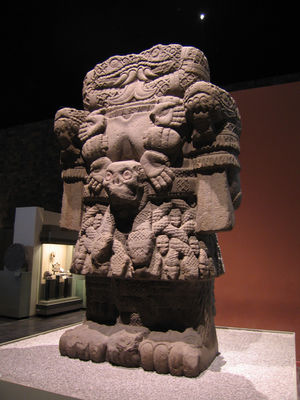
Coatlicue statue
Encyclopedia

Andesite
Andesite is an extrusive igneous, volcanic rock, of intermediate composition, with aphanitic to porphyritic texture. In a general sense, it is the intermediate type between basalt and dacite. The mineral assemblage is typically dominated by plagioclase plus pyroxene and/or hornblende. Magnetite,...
statue usually identified with the Aztec
Aztec
The Aztec people were certain ethnic groups of central Mexico, particularly those groups who spoke the Nahuatl language and who dominated large parts of Mesoamerica in the 14th, 15th and 16th centuries, a period referred to as the late post-classic period in Mesoamerican chronology.Aztec is the...
goddess Coatlicue
Coatlicue
Coatlicue, also known as Teteoinan , "The Mother of Gods" , is the Aztec goddess who gave birth to the moon, stars, and Huitzilopochtli, the god of the sun and war...
("snakes-her-skirt"). It is currently located in the National Museum of Anthropology in Mexico City
Mexico City
Mexico City is the Federal District , capital of Mexico and seat of the federal powers of the Mexican Union. It is a federal entity within Mexico which is not part of any one of the 31 Mexican states but belongs to the federation as a whole...
.
On the bottom of the statue, not normally visible, is a carving of Tlaltecuhtli
Tlaltecuhtli
Tlaltecuhtli, Tlaltecutli is a pre-Columbian Mesoamerican deity figure, identified from sculpture and iconography dating to the Late Postclassic period of Mesoamerican chronology , primarily among the Mexica and other Nahuatl-speaking cultures...
("earth-lord").
Discovery
The statue was discovered in the main plaza of Mexico CityMexico City
Mexico City is the Federal District , capital of Mexico and seat of the federal powers of the Mexican Union. It is a federal entity within Mexico which is not part of any one of the 31 Mexican states but belongs to the federation as a whole...
on 13 August 1790. The sun stone
Aztec sun stone
The Aztec calendar stone, Mexica sun stone, Stone of the Sun , or Stone of the Five Eras, is a large monolithic sculpture that was excavated in the Zócalo, Mexico City's main square, on December 17, 1790. It was discovered whilst Mexico City Cathedral was being repaired...
(also known as the "calendar stone") was found nearby on 17 December.
The first scholar to study the statue was Antonio de León y Gama
Antonio de León y Gama
Antonio de León y Gama was a Mexican astronomer, anthropologist and writer. When in 1790 the Aztec calendar stone was discovered, he published an essay about it, Descripción histórica y cronológica de las dos piedras que con ocasión del nuevo empedrado que se está formando en la plaza principal...
, who incorrectly identified the god depicted as "Teoyamiqui" (i.e. Teoyaomiqui).
Reactions
CriollosCriollo (people)
The Criollo class ranked below that of the Iberian Peninsulares, the high-born permanent residence colonists born in Spain. But Criollos were higher status/rank than all other castes—people of mixed descent, Amerindians, and enslaved Africans...
and Europeans regarded the statue as a horrible, deformed monster. Mexican Indians on the other hand began to worship it, visiting it with candles and adorning it with flowers. To prevent this, the statue was buried in the patio of the University of Mexico where it could not be seen.

Copies
The statue was dug up in 1803, so that Alexander von HumboldtAlexander von Humboldt
Friedrich Wilhelm Heinrich Alexander Freiherr von Humboldt was a German naturalist and explorer, and the younger brother of the Prussian minister, philosopher and linguist Wilhelm von Humboldt...
could make drawings and a cast
Casting
In metalworking, casting involves pouring liquid metal into a mold, which contains a hollow cavity of the desired shape, and then allowing it to cool and solidify. The solidified part is also known as a casting, which is ejected or broken out of the mold to complete the process...
, after which it was reburied. It was again dug up in 1823, so that William Bullock could make another cast, which was displayed the next year in the Egyptian Hall
Egyptian Hall
For the Glasgow building see The Egyptian Halls.The Egyptian Hall in Piccadilly, London, was an Exhibition hall built in the ancient Egyptian style in 1812, to the designs of Peter Frederick Robinson.-History:...
in Piccadilly
Piccadilly
Piccadilly is a major street in central London, running from Hyde Park Corner in the west to Piccadilly Circus in the east. It is completely within the city of Westminster. The street is part of the A4 road, London's second most important western artery. St...
, London
London
London is the capital city of :England and the :United Kingdom, the largest metropolitan area in the United Kingdom, and the largest urban zone in the European Union by most measures. Located on the River Thames, London has been a major settlement for two millennia, its history going back to its...
, as part of Bullock's Ancient Mexico
Ancient Mexico
Ancient Mexico was an exhibition by William Bullock of casts of Aztec artifacts and both copies and originals of Aztec codices, held in 1824 in the Egyptian Hall in Piccadilly, London...
exhibition.

